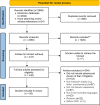Behavioural factors associated with fear of litigation as a driver for the increased use of caesarean sections: a scoping review
- PMID: 37076154
- PMCID: PMC10124311
- DOI: 10.1136/bmjopen-2022-070454
Behavioural factors associated with fear of litigation as a driver for the increased use of caesarean sections: a scoping review
Abstract
Objective: To explore the behavioural drivers of fear of litigation among healthcare providers influencing caesarean section (CS) rates.
Design: Scoping review.
Data sources: We searched MEDLINE, Scopus and WHO Global Index (1 January 2001 to 9 March 2022).
Data extraction and synthesis: Data were extracted using a form specifically designed for this review and we conducted content analysis using textual coding for relevant themes. We used the WHO principles for the adoption of a behavioural science perspective in public health developed by the WHO Technical Advisory Group for Behavioural Sciences and Insights to organise and analyse the findings. We used a narrative approach to summarise the findings.
Results: We screened 2968 citations and 56 were included. Reviewed articles did not use a standard measure of influence of fear of litigation on provider's behaviour. None of the studies used a clear theoretical framework to discuss the behavioural drivers of fear of litigation. We identified 12 drivers under the three domains of the WHO principles: (1) cognitive drivers: availability bias, ambiguity aversion, relative risk bias, commission bias and loss aversion bias; (2) social and cultural drivers: patient pressure, social norms and blame culture and (3) environmental drivers: legal, insurance, medical and professional, and media. Cognitive biases were the most discussed drivers of fear of litigation, followed by legal environment and patient pressure.
Conclusions: Despite the lack of consensus on a definition or measurement, we found that fear of litigation as a driver for rising CS rates results from a complex interaction between cognitive, social and environmental drivers. Many of our findings were transferable across geographical and practice settings. Behavioural interventions that consider these drivers are crucial to address the fear of litigation as part of strategies to reduce CS.
Keywords: maternal medicine; public health; qualitative research.
© World Health Organization 2023. Licensee BMJ.
Conflict of interest statement
Competing interests: None declared.
Figures



Similar articles
-
Folic acid supplementation and malaria susceptibility and severity among people taking antifolate antimalarial drugs in endemic areas.Cochrane Database Syst Rev. 2022 Feb 1;2(2022):CD014217. doi: 10.1002/14651858.CD014217. Cochrane Database Syst Rev. 2022. PMID: 36321557 Free PMC article.
-
Beyond the black stump: rapid reviews of health research issues affecting regional, rural and remote Australia.Med J Aust. 2020 Dec;213 Suppl 11:S3-S32.e1. doi: 10.5694/mja2.50881. Med J Aust. 2020. PMID: 33314144
-
Interventions for fear of childbirth including tocophobia.Cochrane Database Syst Rev. 2021 Jul 7;7(7):CD013321. doi: 10.1002/14651858.CD013321.pub2. Cochrane Database Syst Rev. 2021. PMID: 34231203 Free PMC article.
-
Prevalence of and reasons for women's, family members', and health professionals' preferences for cesarean section in China: A mixed-methods systematic review.PLoS Med. 2018 Oct 16;15(10):e1002672. doi: 10.1371/journal.pmed.1002672. eCollection 2018 Oct. PLoS Med. 2018. PMID: 30325928 Free PMC article.
-
Robson ten group classification system for Caesarean sections across Europe: A systematic review and meta-analysis.Eur J Obstet Gynecol Reprod Biol. 2025 Feb;305:178-198. doi: 10.1016/j.ejogrb.2024.11.052. Epub 2024 Dec 4. Eur J Obstet Gynecol Reprod Biol. 2025. PMID: 39705988
Cited by
-
Global increased cesarean section rates and public health implications: A call to action.Health Sci Rep. 2023 May 18;6(5):e1274. doi: 10.1002/hsr2.1274. eCollection 2023 May. Health Sci Rep. 2023. PMID: 37216058 Free PMC article.
-
How does hospital organisation influence the use of caesarean sections in low- and middle-income countries? A cross-sectional survey in Argentina, Burkina Faso, Thailand and Vietnam for the QUALI-DEC project.BMC Pregnancy Childbirth. 2024 Jan 17;24(1):67. doi: 10.1186/s12884-024-06257-w. BMC Pregnancy Childbirth. 2024. PMID: 38233792 Free PMC article.
-
State-wise variation and inequalities in caesarean delivery rates in India: analysis of the National Family Health Survey-5 (2019-2021) data.Lancet Reg Health Southeast Asia. 2024 Dec 3;32:100512. doi: 10.1016/j.lansea.2024.100512. eCollection 2025 Jan. Lancet Reg Health Southeast Asia. 2024. PMID: 39717057 Free PMC article.
-
Reducing caesarean section rates in Robson groups 1 and 3: a quality improvement initiative in a private Brazilian hospital.BMJ Open Qual. 2025 Mar 4;14(1):e003077. doi: 10.1136/bmjoq-2024-003077. BMJ Open Qual. 2025. PMID: 40037900 Free PMC article.
-
A qualitative and quantitative cross-sectional study on the past, present, and future of vaginal delivery: Turkey.Int J Gynaecol Obstet. 2025 Jan;168(1):237-243. doi: 10.1002/ijgo.15849. Epub 2024 Aug 16. Int J Gynaecol Obstet. 2025. PMID: 39148484 Free PMC article.
References
Publication types
MeSH terms
Grants and funding
LinkOut - more resources
Full Text Sources
Medical
Research Materials
